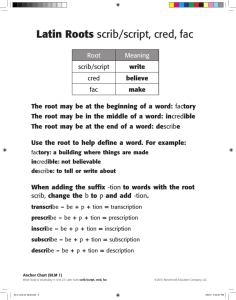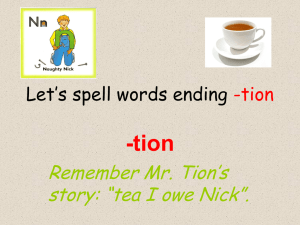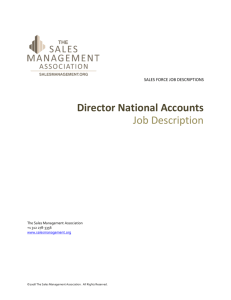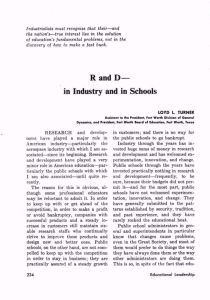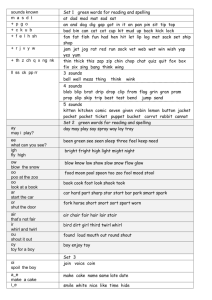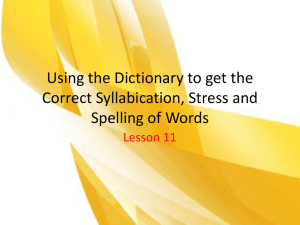Perspectives from Campus Leaders on the Current State of Student
advertisement
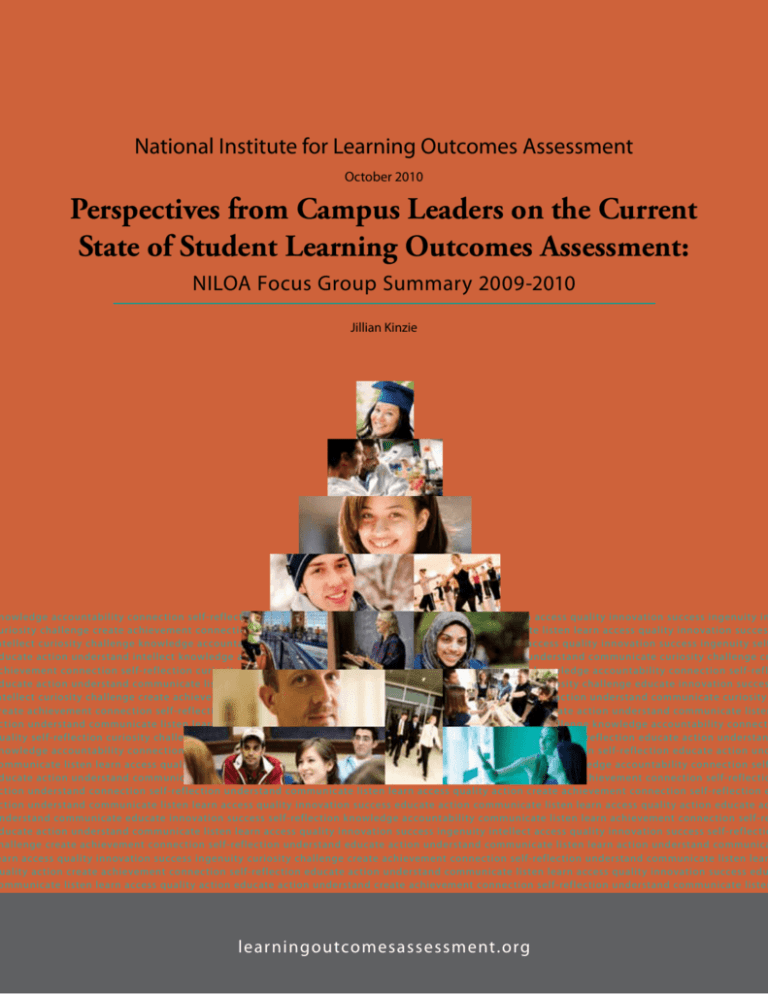
National Institute for Learning Outcomes Assessment October 2010 Perspectives from Campus Leaders on the Current State of Student Learning Outcomes Assessment: NILOA Focus Group Summary 2009-2010 Jillian Kinzie nowledge accountability connec tion self-reflec tion educate ac tion understand communicate listen learn access quality innovation success ingenuity in uriosity challenge create achievement connec tion self-reflec tion educate ac tion understand communicate listen learn access quality innovation succes ntellec t curiosity challenge k nowledge accountability connec tion understand communicate listen learn access quality innovation success ingenuity self ducate ac tion understand intellec t k nowledge accountability connec tion self-reflec tion educate ac tion understand communicate curiosity challenge cr chievement connec tion self-reflec tion curiosity challenge create achievement connec tion self-reflec tion k nowledge accountability connec tion self-refl ducate ac tion understand communicate listen learn access quality innovation success ingenuity intellec t curiosity challenge educate innovation succes ntellec t curiosity challenge create achievement k nowledge accountability connec tion self-reflec tion educate ac tion understand communicate curiosity reate achievement connec tion self-reflec tion understand communicate listen learn access quality ac tion educate ac tion understand communicate listen c tion understand communicate listen learn access quality innovation success ingenuity intellec t curiosity challenge k nowledge accountability connec t uality self-reflec tion curiosity challenge create achievement learn access quality innovation success ingenuity self-reflec tion educate ac tion understan nowledge accountability connec tion self-reflec tion educate ac tion understand k nowledge accountability connec tion self-reflec tion educate ac tion und ommunicate listen learn access quality innovation success ingenuity intellec t curiosity challenge connec tion k nowledge accountability connec tion self ducate ac tion understand communicate listen learn access quality innovation success ingenuity challenge create achievement connec tion self-reflec tio c tion understand connec tion self-reflec tion understand communicate listen learn access quality ac tion create achievement connec tion self-reflec tion e c tion understand communicate listen learn access quality innovation success educate ac tion communicate listen learn access quality ac tion educate ac nderstand communicate educate innovation success self-reflec tion k nowledge accountability communicate listen learn achievement connec tion self-re ducate ac tion understand communicate listen learn access quality innovation success ingenuity intellec t access quality innovation success self-reflec tio hallenge create achievement connec tion self-reflec tion understand educate ac tion understand communicate listen learn ac tion understand communica earn access quality innovation success ingenuity curiosity challenge create achievement connec tion self-reflec tion understand communicate listen lear uality ac tion create achievement connec tion self-reflec tion educate ac tion understand communicate listen learn access quality innovation success edu ommunicate listen learn access quality ac tion educate ac tion understand create achievement connec tion self-reflec tion understand communicate listen learningoutcomesassessment.org National Institute for Learning Outcomes Assessment | 1 “How do we know what academic leaders think about assessment unless we ask them? In this paper, presidents, provosts and academic deans candidly describe what’s happening on their campus in terms of measuring student learning and what needs to happen next to advance the assessment agenda.” Contents George D. Kuh NILOA Director Indiana University Chancellor’s Professor Emeritus A special thank you to : Abilene Christian University Adrian College Albany State University Auburn University Augustana Bates College Brigham Young University Carleton College Central Piedmont Community College City University of New York Herbert H. Lehman College City University of New York La Guardia Community College Clark University California State University Monterey Bay Drew University Eastern Kentucky University Hobart William Smith Colleges Illinois Wesleyan Indiana University-Purdue University Indianapolis Luther College McDaniel College Miami-Dade College Minnesota State community and tribal colleges Niagara University Oakton Community College Oregon State University Oregon University System Pennsylvania State University Richland College Rutgers, The State University of New Jersey Newark Campus Saint Joseph College San Diego State University San Francisco State University Syracuse University The Ohio State University Towson University, University of Houston University of Iowa University of North Texas University of Wisconsin Colleges Ursinus College US Military Academy at West Point Vanderbilt Washington and Jefferson College Westminster College Abstract...3 Perspectives from Campus Leaders on the Current State of Student Learning Assessment: NILOA Focus Group Summary 20092010... 4 Introduction...4 Assessment has generally taken root and on many campuses student learning outcomes assessment is thriving...5 Accreditation is the major catalyst for the assessment of student learning...6 Faculty involvement is key to meaningful assessment...8 Assessment is furthered when woven into established structures and processes...9 Final Thoughts...12 References...14 NILOA National Advisory Panel...15 Mission...15 About NILOA...16 Staff...16 Sponsors...16 National Institute for Learning Outcomes Assessment | 2 intellec t curiosity challenge create achievement connec tion self-reflec tion educate ac tion understand communicate listen learn access quality innovatio success ingenuity intellec t curiosity challenge k nowledge accountability connec tion understand communicate listen learn access quality innovatio success ingenuity self-reflec tion educate ac tion understand intellec t k nowledge accountability connec tion self-reflec tion educate ac tion understan communicate curiosity challenge create achievement connec tion self-reflec tion curiosity challenge create achievement connec tion self-reflec tio k nowledge accountability connec tion self-reflec tion educate ac tion understand communicate listen learn access quality innovation success ingenuit intellec t curiosity challenge educate innovation success ingenuity intellec t curiosity challenge create achievement k nowledge accountability connec tio self-reflec tion educate ac tion understand communicate curiosity challenge create achievement connec tion self-reflec tion understand communicate liste learn access quality ac tion educate ac tion understand communicate listen learn ac tion understand communicate listen learn access quality innovatio Perspectives from Campus Leaders on the Current State of Student Learning Assessment: NILOA Focus Group Summary 2009-2010 Abstract The assessment of student learning outcomes is of keen interest to the federal government, accrediting bodies, and education associations and policymakers. Colleges and universities have been under increased pressured to demonstrate accountability for student learning and be more transparent about dimensions of educational quality. Although institutions are responding to these demands, it is not altogether clear where learning outcomes assessment ranks in importance on institutions’ action agenda, or the extent to which colleges and universities are using assessment results to make real improvements in the quality of student learning. The National Institute for Learning Outcomes Assessment (NILOA) is a multiyear effort to understand and further the student learning outcomes agenda nationally. One of NILOA’s primary activities is tracking the journey of higher education institutions responding to the challenge of outcomes assessment. To this end, NILOA conducts surveys, focus groups, and case studies to learn more about what colleges and universities are doing to assess student learning and how they are using the results. This paper highlights lessons from four focus group sessions with campus leaders – presidents, provosts, academic deans and directors of institutional research from a variety of two- and four-year institutions – regarding their perspectives on the state of learning assessment practices on their campuses. The perceptions are considered in relation to findings from the 2009 NILOA survey report, More Than You Think, Less Than We Need: Learning Outcomes Assessment in Higher Education. The perspectives of campus leaders provide first-hand accounts of a range of student learning outcomes activities on campus and help contextualize results from the 2009 NILOA survey. Focus group findings illustrate the extent to which assessment has taken hold on campus, explicate the role of accreditation and the responsibility of faculty in student learning outcomes assessment, and showcase how assessment has been furthered on campuses. The institutional examples of innovative assessment practices, particularly those that involve faculty in meaningful ways and lead to institutional improvements, and the promising ways that assessment has been woven into administrative structures and processes, are instructive for advancing understanding of what is happening on the ground at colleges and universities. The paper concludes by articulating questions and challenges raised by campus leaders including reservations about identifying and using assessment measures, issues of transparency and communicating results, and concerns about financing assessment. As the demand for greater emphasis on student learning outcomes assessment intensifies, it is important to document both the successes and challenges associated with campus efforts to respond. Campus leaders provide an important perspective on what is most likely to help assessment efforts grow and deepen in institutions. National Institute for Learning Outcomes Assessment | 3 learn access quality ac tion educate ac tion understand communicate listen learn ac tion understand communicate listen learn access quality innovatio success ingenuity intellec t curiosity challenge k nowledge accountability connec tion access quality self-reflec tion curiosity challenge create achievemen learn access quality innovation success ingenuity self-reflec tion educate ac tion understand intellec t k nowledge accountability connec tion self-reflec tio educate ac tion understand k nowledge accountability connec tion self-reflec tion educate ac tion understand communicate listen learn access qualit innovation success ingenuity intellec t curiosity challenge connec tion k nowledge accountability connec tion self-reflec tion educate ac tion understan communicate listen learn access quality innovation success ingenuity challenge create achievement connec tion self-reflec tion educate ac tion understan communicate listen learn achievement connec tion self-reflec tion educate ac tion understand communicate listen learn access quality innovation succes ingenuity intellec t access quality innovation success self-reflec tion curiosity challenge create achievement connec tion self-reflec tion understand educat Perspectives from Campus Leaders Introduction The assessment movement in higher education reached a new level of prominence in the last several years. Coinciding with critical reports and action from Washington, college and university leaders and member organizations such as the American Council on Education (ACE), American Association of Community Colleges (AACC), American Association of State Colleges and Universities (AASCU), Association of American Colleges and Universities (AAC&U), Association of Public Land-grant Universities (APLU), and Council of Independent Colleges (CIC) are advocating for reform from within based on evidence of student and institutional performance. All of this suggests the assessment of student learning outcomes remains of keen interest to the federal government, accrediting bodies, association leaders, funders, and policymakers. But what is happening on the ground—at colleges and universities? What is the current state of student learning outcomes assessment in U.S. colleges and universities? Where does assessment rank in importance on an institution’s action agenda? To what extent are faculty involved in assessment activities and using the results for improving student learning? What is the current state of student learning outcomes assessment in U.S colleges and universities? Where does this rank in importance on an institution’s action agenda? To what extent are faculty involved in assessment activities and using the results for improving student learning? The National Institute for Learning Outcomes Assessment (NILOA) is a multiyear effort to further the student learning outcomes agenda nationally. One of NILOA’s primary activities is tracking the journey of higher education institutions responding to the challenge of assessing learning. To this end, NILOA conducts surveys, focus groups, and case studies to learn more about what colleges and universities are doing to assess student learning and how they are using the results. To gain the perspective of campus leaders regarding the state of learning outcomes assessment on campus, NILOA conducted four focus groups during the 2009–2010 academic year with academic deans, provosts, presidents, and directors of institutional research from a variety of two- and fouryear institutions. Roundtable discussions—conducted at two meetings of the Association of American Colleges and Universities (AAC&U), at the ACE, and at national meetings of the Association for Institutional Research (AIR)—included 45 academic leaders representing a range of institutional types and regions. This paper highlights lessons from these sessions and considers how the perceptions of academic leaders comport with findings from the 2009 NILOA survey report of efforts at colleges and universities to measure student learning, More Than You Think, Less Than We Need: Learning Outcomes Assessment in American Higher Education.1 Based on conference registration lists, invitations to NILOA’s focus groups ensured the representation of a range of institution types among about half of the participants; invitations to the other participants were based on position or involvement with assessment activities. Because our recruiting likely attracted campus leaders with an interest in student learning outcomes assessment, their views may not represent the state of the art of assessment nationally. 1 www.learningoutcomesassessment.org/NILOAsurveyresults09.htm National Institute for Learning Outcomes Assessment | 4 To frame the focus group discussions, the following questions were provided to participants in advance: • Where does the assessment of student learning outcomes fall on the institution’s action agenda? • Who provides leadership for assessment on campus? • If, how, and to what extent are learning outcomes data shared internally and externally? • How have faculty been involved in meaningful assessment work? • How have student learning outcomes assessment results been used in institutional improvement efforts? • What are the key challenges that need to be addressed to use learning outcomes data effectively? Our goal in these focus groups was to obtain first-hand accounts of the state of efforts underway on campuses. The assembled leaders offered constructive comments and specific illustrations of the student learning outcomes agendas on their campuses. Four prominent themes cutting across these discussions organize this paper’s main ideas: 1. Assessment has taken root and is thriving on many campuses. Our goal in these focus groups was to obtain first-hand accounts of the state of efforts underway on campuses. The assembled leaders offered constructive comments and specific illustrations of the student learning outcome agenda on their campuses. Visible efforts like the VSA and U-CAN, have helped expand discussions about assessment and accountability among campus constituents and, particularly, with external stakeholders. 2. Accreditation is the major catalyst for student learning outcomes assessment. 3. Faculty involvement is central to meaningful assessment. 4. Assessment is furthered when woven into established structures and processes. Assessment has generally taken root and on many campuses student learning outcomes assessment is thriving. In the last decade, assessment has realized some important developmental steps. According to the dean at Drew University, “We’re in a different place than 10 years ago. There is a core of people who believe in assessment and work with their colleagues on outcomes assessment.” Most campus leaders credited regional and professional accreditation processes with helping assessment take root on campus, as the next section elaborates. Several leaders indicated that visible efforts like the Voluntary System of Accountability (VSA) and the National Association of Independent Colleges and Universities’ (NAICU) U-CAN have helped expand discussions about assessment and accountability among campus constituents and, particularly, with external stakeholders. Considerable progress has been made in developing assessment systems in the private liberal arts college sector—largely attributable to The Teagle Foundation, which has invested heavily in supporting assessment of student learning at hundreds of institutions since 2004.2 Several representatives from private institutions reported that prior to Teagle investments virtually no assessment activity was happening on their campuses, even as recently as five years ago. 2 See www.teaglefoundation.org/grantmaking/overview.aspx National Institute for Learning Outcomes Assessment | 5 Luther College’s dean reported that learning outcomes assessment practices on that campus have matured over the last several years, declaring that at least half of the faculty are now involved in assessment and that academic program review has become more important and meaningful. Luther College is also expanding its knowledge about student learning outcomes through its work with a consortium of Midwestern colleges partnering in the assessment of writing and critical thinking. At Oregon State University and Towson University, all undergraduate programs now have learning outcomes, and Towson’s president reported that using a Total Quality Management (TQM) approach has helped faculty understand how to use data for improvement. After a spotless accreditation review, Eastern Kentucky University has continued making strides in assessment by embarking on an extensive review of course syllabi to examine the consistency of learning outcomes across course sections. A president in the California state university system, declaring that assessment was being aggressively promoted at the system level, said, “We’ve been assessing everything that moves.” Most presidents of state universities participating in the focus groups reported that over the last ten years whole offices have been established on their campuses charged with conducting and supporting assessment activities. Assessment took hold at an institution when its efforts originated from a genuine interest in knowing more about how well students were learning and whether the institution could make definite claims about outcomes. Several campus leaders reported that assessment took hold at their institution when these efforts originated from a genuine interest in knowing more about how well students were learning and whether the institution could make definite claims about outcomes. For example, discussions in the strategic planning process at Westminster College about what it means to be a Westminster graduate led to the articulation of learning goals specific to a Westminster education. Working systematically to turn these goals into graduation requirements, Westminster developed rubrics to assess learning in each academic program. To the pleasant surprise of Westminster’s president, the faculty were backing these planning and assessment activities and, as a byproduct, were shifting their focus from teaching to learning. The few presidents and deans in the focus groups who did not view their institutions’ efforts as very far along identified the struggle of adopting learning outcomes as being due to faculty holding onto turf—specifically, the grading process— combined with faculty willingly giving up the evaluation of culminating learning to someone else, namely, standardized achievement tests such as the MCAT and GRE. Most campus leaders commented that the key to advancing assessment is for assessment activities to flow more directly out of existing processes for learning. While the possibility that an institution’s data might be misunderstood or misused is an acknowleged barrier, the new challenge at many campuses reporting significant advances in assessment activity, interestingly, is how to use an astounding amount of data. Accreditation is the major catalyst for the assessment of student learning. Results from the 2009 NILOA Survey revealed that across all institutional types, regional and specialized accreditation is the primary driver for student learning outcomes assessment activity. Provosts also reported through this survey that the most common use of assessment data is related to accreditation — trumping all other uses including National Institute for Learning Outcomes Assessment | 6 informing strategic planning, improving instructional performance, and evaluating units or programs. Comments from the academic leaders in our focus groups supported these survey results and provided specific examples of accreditation’s strong role both in the use of assessment results as well as in the motivation for assessment—with nearly all campus leaders describing most of their assessment activity as related to accreditation, either in response to a reaccreditation recommendation about assessment practices or in preparation for an upcoming visit. One administrator commented that, while it is acceptable for accreditation to drive assessment, the problem is that student learning outcomes assessment results are rarely used to drive institutional improvement and resource allocation. Another administrator lamented that because accreditation is motivated by a compliance mentality, emphasizing “what needs to be done to get through,” little attention is paid to the interests and questions important to the institution about the quality of student learning and educational effectiveness. Although the general complaint from campus leaders was that the compliance mentality typically adopted for accreditation can make assessment less meaningful, several campus leaders described using accreditation as a lever for assessment. When Roosevelt University started planning for their Higher Learning Commission (HLC) reaffirmation process, for example, university leaders and faculty intent on achieving a ten-year approval suggested the best way to achieve this would be to take the initiative to develop meaningful assessments while ensuring that activities and evidence satisfied the HLC requirements. Signaling this was important to the institution, the president, a couple of associate deans, and several senior faculty leaders signed up to participate in the HLC Assessment Academy for further education and structured support and then devoted time to translating HLC standards into institutional purposes. Infusing learning outcomes into academic programs and majors came rather naturally to faculty, as they “own” this area of the curriculum, but identifying learning outcomes and aligning assessments was more difficult in general education. Another administrator lamented that because accreditation is motivated by a compliance mentality, emphasizing “what needs to be done to get through”, little attention is paid to the interests and questions important to the institution about the quality of student learning and educational effectiveness. The president at Richland College of the Dallas County Community College District reported that as the institution began its Southern Association Commission for Schools (SACS) reaccreditation process the worry was that the process would take the institution off course. However, key leaders took advantage of the flexibility of the pilot Quality Enhancement Plan (QEP) process and of the opportunity to tailor a project emerging from the concerns of faculty and staff, he said, resulting in a project almost everyone was committed to seeing through—adding, “The QEP process worked for us, the accreditation processes ended, but the work on the QEP continued.” Several academic leaders explicitly mentioned that a negative accreditation review had stimulated activity on their campuses. As the dean of Centre College put it, “There had been lots of talk [up to then]… now we have to do it.” A president whose institution is accredited by the Middle States Association (MSA) reported that the MSA review— which concluded that the institution had made progress but needed to do more—had been sobering but had stimulated immediate action on his campus. National Institute for Learning Outcomes Assessment | 7 Both regional and specialized professional accrediting agencies were identified as exerting a strong influence on assessment activities. Professional accrediting agencies moved assessments forward at the program level. One president described how an upcoming visit by ABET, the engineering accreditor, prompted his institution to identify common learning outcomes across all engineering courses. Accreditation also made it possible for faculty committed to assessment and doing it on their own to receive positive attention for these efforts. Accreditation is clearly a driver for assessment. The bad news is that student learning outcomes are still being used more to respond to accreditation demands than to improve student learning, determine resource allocation, or guide strategic planning. A concern also remains that accreditation devalues assessment for improvement. One dean’s remark particularly illustrated this: “We were advised by our accreditors not to post ‘directions for future study’ on our website and to only post the glowing aspects of our self-study.” This underscores the long-standing tension Peter Ewell (2009) has described between assessment for improvement versus assessment for accountability. Accreditation is clearly a driver for assessment. The bad news is that student learning outcomes are still being used more to respond to accreditation demands, than to improve student learning, determine resource allocation, or guide strategic planning. Faculty involvement is key to meaningful assessment. According to presidents, deans, and directors of institutional research, the depth and meaning of assessment is only as good as the scope and quality of faculty involvement. When asked what is most needed to more effectively assess and use student learning outcomes, provosts responding to the 2009 NILOA survey indicated that gaining more faculty engagement is the major challenge. The campus leaders in our focus groups tended to share the dominant view that faculty, by and large, do not like assessment. A dean commented that faculty consider assessment a “distraction from the important job of teaching” and believe course grades already provide sufficient information about how well students are learning. Compounding this general concern was the idea that several of the current goals for educational effectiveness—such as increased student retention, improved graduation rates, and other measures of “institutional effectiveness”—are considered outside the purview and interest of faculty. Faculty were characterized as being particularly interested in assessment evidence directly related to teaching and learning. Several focus group participants reported, for example, that faculty get engaged when reviewing student work. According to a liberal arts college dean, “Faculty want to evaluate student work and want to talk about what it demonstrates in terms of student learning.” The dean at Hobart and William Smith Colleges indicated that about a third of the faculty there have actively generated learning goals for their courses and are seeking some outcomes measures, but these efforts are highly particularized and specific to students in their courses. Reporting that The Teagle Foundation’s efforts to convene faculty from multiple institutions to discuss how to improve student learning has “softened faculty resistance to assessment,” this dean noted that “the minute talk turns to student work, and faculty have students or student artifacts in front of them, then the discussion is highly energized and constructive.” She explained further that the most exciting, genuine, and transformational element of the assessment efforts at the institution was associated with its Center for National Institute for Learning Outcomes Assessment | 8 Teaching and Learning, which translates assessment results into targeted workshops throughout the year for faculty, for example, workshops on syllabus design and on increasing the use of engaging pedagogies. The president of CUNY LaGuardia indicated she has seen great improvements in pedagogy as a result of her institution’s faculty developing a more meaningful approach to assessing student work—including rubrics they created to assess student learning for what they expect in beginning, middle, and late student work. Rubrics and e-portfolios have captured the interest of faculty and students at LaGuardia and have fueled discussion about how student work can be used for faculty-led program assessment. At another public university, where the required capstone course in each major was viewed the most productive site to involve faculty in assessment, the emphasis on describing a final product that would accurately reflect students’ culminating work in the field made faculty more inclined to inquire about what that product indicates about student learning outcomes. One approach to involving faculty in assessment advocated by some campus leaders is to simply avoid the term “assessment” wherever possible. As one dean put it, “There is lots of interest in the topic, but not in the technique or superstructure.” Helping faculty improve their evaluation of student work is one alternative approach; another suggested way into the topic is to use every opportunity to ask faculty “How do you make academic decisions about what to teach and how do you know what your students are learning?” When a department at Ohio State University updates its curriculum, for example, its documentation must include the department’s goals for student learning outcomes and also descriptions of the methods to assess these outcomes. This approach has helped facilitate the gradual phasing in of required learning goals and plans for assessment across a variety of departments at that institution. Finally, directors and staff of institutional research offices saw themselves as resources for faculty looking to improve their assessment practice. Most agreed that reaching out to help faculty with their assessment needs was essential but that it was important not to dictate approaches or processes. One approach suggested to involve more faculty in assessment was to identify faculty members who already had assessment expertise, via workshops or part-time appointments, and assessment experience to serve as liaisons or mentors to their more reluctant colleagues. Assessment is furthered when woven into established structures and processes. Significant progress in the assessment of student learning outcomes was reported by nearly all campus leaders in the focus groups. Some of these advances were in response to external requirements from accreditation and other influential stakeholders including foundation and member organizations, and others grew out of greater investments by faculty. Whatever the impetus, most of the advances also involved the creation of structures and mechanisms to support and sustain assessment activities. Campus leaders described that some of the specific practices associated with getting more faculty invested and making assessment activities more widespread included making assessment part of standard institutional policies and procedures. When a department at Ohio State University updates its curriculum, for example, its documentation must include the department’s goals for student learning outcomes and also descriptions of the methods to assess National Institute for Learning Outcomes Assessment | 9 these outcomes. This approach has helped facilitate the gradual phasing in of required learning goals and plans for assessment across a variety of departments at that institution. Albany State University adopted a similar approach by streamlining its required reports; every report required there—program reviews and annual reports as well as assessment reports—must include information about student learning outcomes. The director of institutional research elaborated on that university’s structured approach: There is a required assessment plan from every department and program every two years that’s based on a student learning outcome. In addition, one element of the required annual report is that they have to tell us how they have implemented their assessment findings in terms of enhancing their activities to produce student learning outcomes. These two reports help make assessment seem a little less painful for the faculty members and the faculty who serve as program coordinators and department chairs because all they have to do is take one report and think about what have we done to meet these learning outcomes and update that report over time for different purposes. Albany State University adopted a similar approach by streamlining its required reports; every report required there—program reviews and annual reports as well as assessment reports—must include information about student learning outcomes. The Ohio State and Albany State University examples demonstrate the potential for embedding assessment into existing processes. Organizational structures for assessment have also made a difference. A director of institutional research at a community college reported that assessment really took hold on her campus when it created an administrative position—associate dean for student learning— charged with assessment. To carry out this charge, the associate dean works with committees composed largely of faculty charged with developing assessment plans. Two faculty members from one of the committees concentrating on career and technical education met with each of the program chairs to talk about the program’s learning objectives and to help them develop clearly defined, assessable learning objectives. Now each program at the college has a set of objectives, and chairs and faculty are working on identifying how they will assess student learning of those objectives. While crediting the structure, this director also noted that the faculty members’ visits with the program chairs had made a difference: “They were peers, there were two of them, they provided help, not just directives but help as peers working together.” Having created the position of assessment director to lead its assessment initiatives, Albany State University built its own cadre of assessment experts through rotating, two-year appointments to this position, with course release time for faculty members. After serving their twoyear term as assessment director, these faculty members return to their departments—with two years of assessment experience under their belts. According to the director of institutional research, National Institute for Learning Outcomes Assessment | 10 The faculty members’ colleagues are now going to him [the faculty member who rotated out of the term] whenever they have assessment questions…. The assessment director that we have now is from the college of sciences and health professions so we’ll work with her for two years and then she’ll rotate back to her full college duties and we’ll pick somebody else hopefully from either the college of business or the college of education and we plan to do this in this rotating model until we have faculty experts in assessment in every college. The terms of this appointment make it attractive for faculty members to rotate in; rotating out, that person has assessment experience and the institution has an additional assessment resource on campus. A modification of the structured approaches outlined above has been employed at the University of Missouri, where the director of the office of assessment has moved assessment efforts forward by working with programs he perceives want to work with him. On first meeting with program faculty, he asks, “Well, what do you want your undergraduates to be able to do?” Working backward from there, he consults with faculty to revise curriculum and to identify appropriate measures and tools, also advising them how to use data to inform their improvement efforts. While this “backward design” approach has worked well at Missouri, producing some elaborate assessment plans and processes in its programs, the voluntary nature of this approach—allowing some departments and programs to defer participation—is a drawback. Several deans and directors of institutional research in the focus groups emphasized that the natural way for an institution to begin advancing assessment is by looking at what faculty members are already doing in their classrooms in terms of learning outcomes assessment. Several deans and directors of institutional research in the focus groups emphasized that the natural way for an institution to begin advancing assessment is by looking at what faculty members are already doing in their classrooms in terms of learning outcomes assessment. The associate director for assessment at Auburn University along with her colleagues illustrated ways that data used to “grade students” could be used for learning outcomes assessment—for example, by using certain science course test items to demonstrate desired competencies, with the collection of the agreed items later forming the basis of an instrument to assess scientific literacy. In some of the focus group participants’ institutions, faculty needed help bringing their assessment practices into the spotlight. Some faculty members found welcome connections between their assessment activities and the scholarship of teaching and learning, or within centers for teaching and learning, while others benefited from being involved in cross-campus and in some cases cross-institution initiatives. Setting up the infrastructure for more collegial approaches to assessment—such as the consortium coordinated by The Teagle Foundation and other less formal campus-based arrangements organized by centers for teaching and learning—seemed to have been effectively employed at small, private liberal arts colleges. One liberal arts college president asserted that assessment is best when it flows from standard processes of teaching, faculty development, and reporting structures. National Institute for Learning Outcomes Assessment | 11 Final Thoughts The assessment of student learning outcomes remains a high priority on the institutional agenda. The campus leaders in our focus groups said that assessment efforts are growing and deepening on their campuses but that these efforts are primarily impelled by accreditation and other national accountability initiatives. While support from campus leadership is essential, real progress requires faculty members to take ownership of assessment processes and outcomes, particularly at small colleges and universities, and for infrastructure and policies to be streamlined to support assessment activities.3 Support from campus leadership is also essential to furthering the assessment of student learning. It is not incidental that of the 45 presidents, deans, and institutional research staff participating in our focus groups, nearly all knew a lot about the specifics of their campus assessment practices. As we noted earlier, campus leaders who accepted our focus group invitation may be relatively more concerned and knowledgeable about assessment and, therefore, more inclined to discuss it. Even so, we were mildly surprised that presidents at several institutions provided extensive details on things like their institutions’ attempts to implement e-portfolios and that several deans described the specific challenges of getting students to participate in direct measures of learning such as the Collegiate Learning Assessment. Institutional leaders raised important questions about the state of assessment efforts on campuses and in higher education. Several presidents and deans reported difficulty in making the right choices about assessment tools and approaches, one dean noting, “We are confronted with a bewildering array of techniques and instruments.” Another expressed concern related to the public disclosure of assessment results. Despite transparency initiatives like the VSA and NAICU’s U-CAN, making assessment results public, particularly results of student learning outcomes assessment, is regarded with some trepidation. While support from campus leadership is essential, real progress requires faculty members to take ownership of assessment processes and outcomes, particularly at small colleges and universities, and for infrastructure and policies to be streamlined to support assessment activities. The focus groups’ campus leaders articulated the following questions regarding challenges and concerns related to identifying and using assessment measures, communicating assessment results, and motivating their campuses for assessment efforts: • Assessment Measures. What is the right balance between institutionally developed measures and nationally benchmarked instruments? Standardized measures seem to yield “one number”; are these numbers actually useful for anything besides comparisons between institutions? What are the validity and reliability of faculty-created rubrics and e-portfolios; how can the information gained from these tools be defended as evidence of student learning outcomes? • Communicating Results. To what extent are institutions transparent regarding student learning outcomes results? Would it help even the playing field if accreditation standards required institutions to make public their self-study reports, student learning outcomes results, and final disposition letters? Should institutional improvement plans be posted along with learning outcomes results? How will external publics react if an institution identifies several areas needing improvement? How can an institution keep the perception of the needed See Pat Hutchings’s Opening Doors to Faculty Involvement in Assessment for ways into such ownership through six strategies to make faculty involvement more likely and assessment more useful. 3 National Institute for Learning Outcomes Assessment | 12 improvement from becoming distorted? How might current platforms for posting results help generate discussion about using results to make improvements? • Motivation for Assessment. What does it mean for institutions that accreditation is driving assessment? Is assessment going where institutions want it to go? Who should be deciding what to assess? What value should presidents and other key higher education leaders place on the assessment of student learning? Campus leaders also noted the importance of including more higher education stakeholders in institutional assessment efforts. Increasing board-of-trustees involvement in assessment was viewed as helpful. According to one dean, “It is reinforcing to have board members asking questions about learning outcomes assessment.” Other institutions reported that assessment activity increased when they leveraged student involvement in it. In response to a Northwest Commission on Colleges and Universities standard that learning outcomes be published for students, for example, Brigham Young University invited students to help publicize learning outcomes; a task force was established at the university to address this requirement and students helped create a video as well as a wiki site4 to explain and to get the word out about learning outcomes. Finally, as the learning environment expands to include the community and employers, determining the best ways to involve all stakeholders in assessment as well as communicating assessment results to them becomes more challenging. A final concern expressed by campus leaders was about financing assessment. Assessment is seen as resource intensive and—in the face of current budget crises on many campuses—by some leaders, as close to unsustainable. As the learning environment expands to include the community and employers, determining the best ways to include all stakeholders in assessment as well as communicating assessment results to them becomes more challenging. In closing, our focus group results make clear that undertaking assessment primarily to satisfy accreditation requirements weakens both the potential of learning outcomes assessment activities as well as the accreditation process itself. The institutional efforts with the strongest potential to advance assessment are ensuring authentic faculty ownership of it and integrating it into supportive institutional structures. References Ewell, P. T. (2009, November). Assessment, accountability, and improvement: Revisiting the tension (NILOA Occasional Paper No.1). Urbana, IL: University of Illinois and Indiana University, National Institute for Learning Outcomes Assessment. Hutchings, P. (2010, April). Opening doors to faculty involvement in assessment (NILOA Occasional Paper No.4). Urbana, IL: University of Illinois and Indiana University, National Institute for Learning Outcomes Assessment. Kuh, G., & Ikenberry, S. (2009, October). More than you think, less than we need: Learning outcomes assessment in American higher education. (Full Report). Champaign, IL: National Institute for Learning Outcomes Assessment. 4 See http://learningoutcomes.byu.edu/ National Institute for Learning Outcomes Assessment | 13 NILOA National Advisory Panel Trudy W. Banta Professor Indiana University-Purdue University Indianapolis Douglas C. Bennett President Earlham College Robert M. Berdahl President Association of American Universities Molly Corbett Broad President American Council on Education Charlene Nunley Doctoral Program Director Community College Policy and Administration University of Maryland University College Randy Swing Executive Director Association for Institutional Research Carol Geary Schneider President Association of American Colleges and Universities Judith Eaton President Council for Higher Education Accreditation David Shulenburger Vice President Association of Public and Land-Grant Universities Richard Ekman President Council of Independent Colleges Belle Wheelan President Southern Association of Colleges and Schools Joni Finney Practice Professor University of Pennsylvania George Wright President Prairie View A&M University Vice President, National Center for Public Policy and Higher Education Susan Johnston Executive Vice President Association of Governing Boards Paul Lingenfelter President State Higher Education Executive Officers George Mehaffy Vice President Academic Leadership and Change American Association of State Colleges and Universities National Institute for Learning Outcomes Assessment (NILOA) Mission NILOA’s primary objective is to discover and disseminate ways that academic programs and institutions can productively use assessment data internally to inform and strengthen undergraduate education, and externally to communicate with policy makers, families and other stakeholders. Ex-Officio Members Peter Ewell Vice President National Center for Higher Education Management Systems Stanley Ikenberry President Emeritus and Regent Professor University of Illinois George Kuh Chancellor’s Professor Emeritus Indiana University Margaret Miller Professor University of Virginia Editor Change Magazine The ideas and information contained in this publication are those of the authors and do not necessarily reflect the views of Carnegie Corporation of New York, Lumina Foundation for Education, or The Teagle Foundation. National Institute for Learning Outcomes Assessment | 14 About NILOA • The National Institute for Learning Outcomes Assessment (NILOA) was estab• • • • lished in December 2008. NILOA is co-located at the University of Illinois and Indiana University. The NILOA website went live on February 11, 2009. www.learningoutcomesassessment.org One of the co-principal NILOA investigators, George Kuh, founded the National Survey for Student Engagement (NSSE). The other co-principal investigator for NILOA, Stanley Ikenberry, was president of the University of Illinois from 1979 to 1995 and of the American Council of Education from 1996 to 2001. NILOA Staff NATIONAL INSTITUTE FOR LEARNING OUTCOMES ASSESSMENT Stanley Ikenberry, Co-Principal Investigator George Kuh, Co-Principal Investigator Peter Ewell, Senior Scholar Staci Provezis, Project Manager Jillian Kinzie, Associate Research Scientist Natasha Jankowski, Research Assistant Gloria Jea, Research Assistant NILOA Sponsors Carnegie Corporation of New York Lumina Foundation for Education The Teagle Foundation Produced by Creative Services | Public Affairs at the University of Illinois for NILOA. 10.032 National Institute for Learning Outcomes Assessment | 15 ducate ac tion understand communicate listen learn access quality innovation success ingenuity intellec t curiosity challenge educate innovation succes ntellec t curiosity challenge create achievement k nowledge accountability connec tion self-reflec tion educate ac tion understand communicate curiosity reate achievement connec tion self-reflec tion understand communicate listen learn access quality ac tion educate ac tion understand communicate listen c tion understand communicate listen learn access quality innovation success ingenuity intellec t curiosity challenge k nowledge accountability connec ti uality self-reflec tion curiosity challenge create achievement learn access quality innovation success ingenuity self-reflec tion educate ac tion understan nowledge accountability connec tion self-reflec tion educate ac tion understand k nowledge accountability connec tion self-reflec tion educate ac tion und ommunicate listen learn access quality innovation success ingenuity intellec t curiosity challenge connec tion k nowledge accountability connec tion self ducate ac tion understand communicate listen learn access quality innovation success ingenuity challenge create achievement connec tion self-reflec tio c tion understand connec tion self-reflec tion understand communicate listen learn access quality ac tion create achievement connec tion self-reflec tion e c tion understand communicate listen learn access quality innovation success educate ac tion communicate listen learn access quality ac tion educate ac nderstand communicate educate innovation success self-reflec tion k nowledge accountability communicate listen learn achievement connec tion self-re ducate ac tion understand communicate listen learn access quality innovation success ingenuity intellec t access quality innovation success self-reflec tio hallenge create achievement connec tion self-reflec tion understand educate ac tion understand communicate listen learn ac tion understand communica earn access quality innovation success ingenuity curiosity challenge create achievement connec tion self-reflec tion understand communicate listen lear uality ac tion create achievement connec tion self-reflec tion educate ac tion understand communicate listen learn access quality innovation success edu ommunicate listen learn access quality ac tion educate ac tion understand create achievement connec tion self-reflec tion understand communicate listen ccess quality ac tion create achievement connec tion self-reflec tion educate ac tion understand communicate listen communicate educate innovation suc eflec tion k nowledge accountability connec tion self-reflec tion educate ac tion understand communicate listen learn access quality innovation ingenuity onnec tion self-reflec tion understand communicate listen learn access quality ac tion create achievement connec tion self-reflec tion educate ac tion unde ommunicate listen learn access quality innovation success educate ac tion communicate listen learn access quality ac tion educate ac tion understand co ducate innovation success self-reflec tion k nowledge accountability innovation communicate listen learn access quality innovation success ingenuity in National Institute for Learning Outcomes Assessment For more information, please contact: National Institute for Learning Outcomes Assessment (NILOA) University of Illinois at Urbana-Champaign 340 Education Building Champaign, IL 61820 learningoutcomesassessment.org sprovez2@illinois.edu Fax: 217.244.3378 Phone: 217.244.2155

